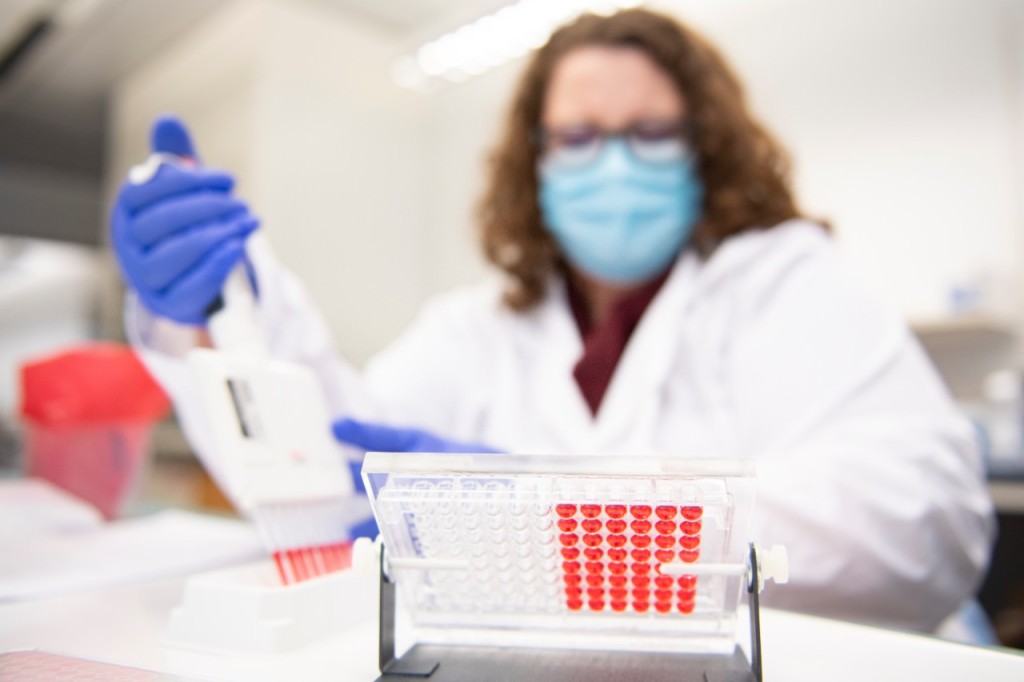UC study found an approved drug could make radiation therapy more effective for head, neck cancer.
Head and neck cancer is the sixth most common cancer worldwide, and while effective treatments exist, sadly, the cancer often returns.
Researchers at the University of Cincinnati have tested a new combination therapy in animal models to see if they could find a way to make an already effective treatment even better.
Since they’re using a Food and Drug Administration-approved drug to do it, this could help people sooner than later.
These findings are published in the journal Cancer Letters.

Head and neck cancer, like any cancer, is truly life-altering. [It] could impact your throat, tongue or nose, and patients often can’t swallow, talk or eat; it truly takes away some of the most social, enjoyable parts of life.
— Christina Wicker, PhD
Christina Wicker, PhD, a postdoctoral fellow in the lab of Vinita Takiar, MD, PhD, led this research which she says will hopefully extend the lives of patients one day.
“Head and neck cancer, like any cancer, is truly life-altering,” she says. “Head and neck cancer could impact your throat, tongue or nose, and patients often can’t swallow, talk or eat; it truly takes away some of the most social, enjoyable parts of life.”
Researchers in this study combined radiation therapy with a drug (telaglenastat) that stops a key enzyme in a cell pathway that becomes altered in cancer cells, causing those cells to grow rapidly and resist treatment. Wicker says this drug has already been studied in multiple clinical trials to see if it could improve treatment of various cancers.
“Until now, no one has examined if this drug has the potential to improve radiation treatment in head and neck cancer. Most importantly, this drug compound has been well tolerated by patients and causes minimal side effects,” she says.

Using animal models, researchers found that the drug alone reduced the growth of head and neck cancer cells up to 90%, and it also increased the efficacy of radiation in animals with head and neck tumors by 40%.
“With these results, and especially with previous clinical trials showing that the drug is well tolerated by patients, there is the potential to move more rapidly into head and neck cancer clinical trials,” Wicker says. “In the future, we hope this drug will be used to make radiation treatments for head and neck cancer even more effective.”
Currently, the most common treatment for that cancer is radiation therapy, but the cancer eventually returns in up to half of patients, Wicker says, and often it doesn’t respond as positively to treatment the second time around.
“When [traditional] drugs are less effective, cancer growth becomes difficult to control, which can lead to the cancer quickly spreading to other organs,” she says. “It is very important that scientists and clinicians develop new cancer treatments to improve treatment of this type of cancer, and hopefully our findings will provide one more option to help patients.”

A passion for science from personal experience
Wicker has studied many types of cancer throughout her academic career. In 2019, she was awarded a Young Investigator Award from the Society of Experimental Biology and Medicine.

She says she decided to pursue science as a career because of her own experience with several disabilities including a rare disorder called Klippel-Feil syndrome, which causes moderate to severe chronic pain on a daily basis.
“Being disabled, I always try to keep the focus on patients’ quality of life,” she says. “Sometimes scientists forget why we do what we do and why we need treatments not just to save lives but to make sure they are [lives] worth living while being treated.”
I’m hoping to help improve inclusion because like other minorities, we bring a very different perspective to further push science and patient advocacy forward.
— Christina Wicker, PhD
Wicker was always very drawn to science, in general, because of the rare or complex medical issues that run in her family and tend to stump physicians; she wanted to do her part to help.
Disabled people are very underrepresented in STEM, Wicker continues, adding that the system isn’t well built for people like her.
“Apparently, only 0.4% of doctorate recipients report having one disability according to the National Science Foundation. So I have no idea what percentage I represent as someone with multiple disabilities and a first-generation college student from a low-income background,” she says. “I’m hoping to help improve inclusion because like other minorities, we bring a very different perspective to further push science and patient advocacy forward.”
This study was funded by a Career Development Award from the Cincinnati Veterans Affairs Medical Center (Takiar) and a Pathways to Cancer Therapeutics training grant (T32CA117846-11A1).
Reference: Christina A. Wicker, Brian G. Hunt, Sunil Krishnan, Kathryn Aziz, Shobha Parajuli, Sarah Palackdharry, William R. Elaban, Trisha M. Wise-Draper, Gordon B. Mills, Susan E. Waltz, Vinita Takiar, Glutaminase inhibition with telaglenastat (CB-839) improves treatment response in combination with ionizing radiation in head and neck squamous cell carcinoma models, Cancer Letters, Volume 502, 2021, Pages 180-188, ISSN 0304-3835, https://doi.org/10.1016/j.canlet.2020.12.038. (http://www.sciencedirect.com/science/article/pii/S030438352100001X)
Provided by University of Cincinnati











